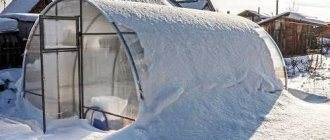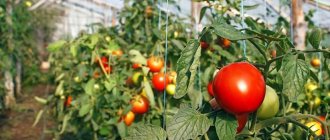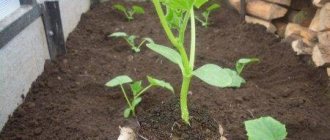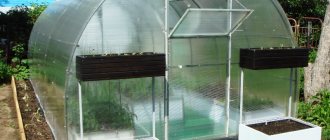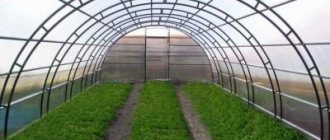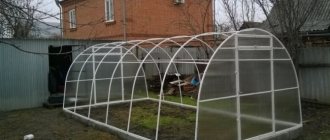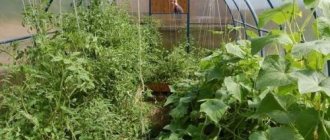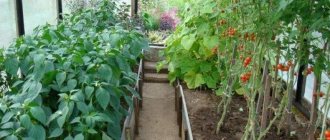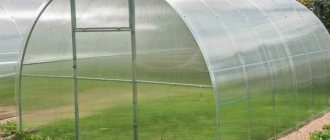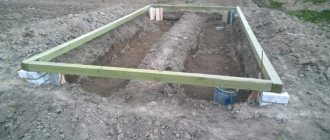Peppers, eggplants, tomatoes and other greenhouse inhabitants wither, their leaves turn yellow, and the plants look stunted, despite regular watering and fertilizing? Perhaps they are simply too hot and do not have enough air. How to fix this problem?
Many novice summer residents believe that by installing a greenhouse, they will immediately solve all the problems with growing heat-loving crops. Alas, this is not entirely true. Firstly, most regions of our country are characterized by sharp temperature changes, leading to plants overheating during the day and freezing at night. And secondly, the heat in the greenhouse does not have a favorable effect on the potential harvest - the plants wither, the pollen becomes sterile, and photosynthesis slows down. To avoid this, it is necessary to maintain a comfortable temperature and humidity level in the greenhouse for the plantings.
Why ventilate a greenhouse?
When starting the process of growing tomatoes, it is recommended to find out in advance why you need to ventilate the greenhouse. This is due to the fact that not all gardeners install ventilation systems. Not all greenhouse structures are equipped with vents or their number does not allow for optimal ventilation. To attract additional air flow, you also need to open the door during the day. If a high greenhouse is chosen for growing, then you need to remove the film in warm weather. The circulation of air flows will allow you to regulate the temperature inside the greenhouse, eliminate excess moisture and condensation, and also remove mold and mildew.
How and how to shade a greenhouse in hot weather?
On a hot summer day, when the temperature outside exceeds 30 degrees, and the sunlight makes the heat deadly, the temperature inside the greenhouse can “go off scale” over 50 degrees. This can lead to the death of plants. Therefore, there is a desire to shade the greenhouse. This can be done in many ways. You can throw some kind of covering material, such as gauze, over the greenhouse and attach the edges to the ground so that it does not blow away in the wind. You can fix such material inside. But there is a simpler and more original method of shading, which we spotted in Turkey. You need to “whiten” the greenhouse by spraying it with chalk solutions. But you should not use any substances that can damage polycarbonate. When the heat subsides, you can clean your greenhouse by spraying it with a hose.
Features of proper ventilation
In order to properly ventilate and not cause harm to the plants, it is recommended to take into account the specifics. Agricultural technology suggests that you should not open the door if watering has been done recently. It should take about 0.5-1 hour. During this time, the moisture will be well absorbed into the soil. Plants will be able to receive nutrients and adapt to a gradual decrease in temperature. If it is not possible to wait in the morning, then it is recommended to water in the evening, and in the morning all that remains is to open the greenhouse door. Ventilation allows you to maintain humidity levels at the same level. Opening the doors helps create optimal conditions for pollination of plants growing indoors. If the humidity levels are too high, the pollen sticks together, resulting in no ovary formation.
When the air inside the greenhouse is too dry, pollen does not germinate, which also leads to the absence of ovaries on the bushes. The recommended humidity level in the greenhouse is 60-70%. To monitor the indicators, you should hang a regular hygrometer in the greenhouse.
You may also be interested: At what temperature do tomatoes freeze in a greenhouse?
Monitoring and maintaining temperature readings is another reason to ventilate. Tomatoes are heat-loving plants, so this indicator is very important for them. Ideal conditions for proper development during the daytime are air temperatures within 20-25 degrees. Night values should not fall below 16 degrees. Such indicators guarantee a high yield and absence of diseases in plants. If the weather is hot outside (from 28 degrees), then ventilation with an open door is a must. Moderate drafts do not cause diseases in tomatoes. On the contrary, they help create an ideal microclimate for the growth and pollination of flowers.
Timely opening and closing of doors to the greenhouse helps prevent rotting of ripening or developing fruits. Their protection from diseases and some pests is also achieved through proper air circulation.
Temperature for seedlings in a greenhouse for different crops
A greenhouse is a small, low structure, completely enclosed with a detachable transparent top cover designed to allow light to pass through and work in the greenhouse. Greenhouses are set up outside and are mostly intended for growing seedlings.
The optimal temperature for growing seedlings depends on the crop
In order for the seedlings to feel comfortable, they must maintain a certain temperature:
- The optimal temperature for growing seedlings depends on the crop. For example, when growing tomato seedlings during the day, the optimal temperature is 18–22°C, and at night 15–18°C. It is best to control the temperature using a thermometer installed inside the greenhouse. For seedlings of other crops, the recommended temperature is 16–25°C during the day, and 12–18°C at night.
- When the daytime temperature reaches about 20°C during the day, the greenhouse should be opened, in the daytime after twelve o'clock in the afternoon for 15 - 30 minutes. And when the minimum day and night temperature outside is 15°C, a small window should be made in the greenhouse to ventilate the greenhouse.
In a greenhouse, it is important to maintain the optimal temperature of not only the air, but also the soil. So for most crops, the soil temperature should be 14 - 25 ° C. This is achieved by introducing biological fuel into the soil, which, when decomposed, will give a certain temperature.
When should you open it for ventilation?
The process of opening and closing greenhouse doors for ventilation depends on environmental conditions. If the daytime temperature is warm (from 24 degrees) and there is no wind, then a draft should be created in the early morning. If the street is cloudy and raining, then ventilation is not carried out or only vents are used for this purpose. The reason is that if the door is opened, moisture will penetrate inside and settle on the walls. As a result, the humidity level will increase. Excessive amounts of it can provoke late blight and fungal diseases.
How to position the greenhouse correctly?
First of all, the greenhouse should be located in a well-lit place. Sunlight should shine on it as long as possible. It is best if the greenhouse is located with its side facing south, since the side surface area is larger than the end area. You should not locate the greenhouse if it is a gable or arched one, close to buildings or a fence. In winter, this will prevent snow from melting and can lead to destruction of the greenhouse. And also, a large mass of snow next to your greenhouse in the spring will melt for a long time, cooling the soil and preventing it from drying out.
Ventilation rules
Like any other agricultural activity, ventilation has a number of rules that must be followed. This will allow you to get a good harvest and avoid various kinds of problems in the process of growing crops:
- If the design involves the presence of vents, then they need to be opened at the top on each side. This way you can remove excess condensation that accumulates on the walls and roof of the greenhouse.
- Warm air will escape faster through the upper vents.
- If it is not hot outside, then it is recommended to open the door for only 1-2 hours.
- At temperatures below +20 degrees, ventilation by opening doors is not carried out, so as not to overcool the tomato bushes.
You may also be interested in: Why do cucumber ovaries rot in a greenhouse?
Temperature is the main factor for a good harvest. Ventilation must be carried out on a regular basis so that the bushes do not overheat. You can start with short air procedures, leave for several hours when the outdoor readings cross the +20 degree mark. If it is raining outside or there is a period of high humidity, then ventilation is not carried out. You can only open the window.
Properly care for tomatoes
| Plant tomatoes according to the scheme Carefully study the information on the seed packaging to understand at what distance to place the plants. Do not violate the manufacturer's recommendations. Prepare the soil in advance and dig holes according to the diagram . Plant in soil that has warmed up to at least +15 degrees | |
| Till the soil Loosen the soil after each watering. This prevents the formation of a hard crust on the surface and reduces the evaporation of moisture from the soil. You can mulch the surface . Peat, humus, sawdust, mown grass or even fir cones are used for this. | |
| Tie up plants The packaging most often indicates whether plants need to be tied up.. But most often the bushes need additional support, especially when grown in a greenhouse. It is most convenient to use a trellis as in the photo . Pieces of twine or fabric tape are lowered to hold the stems, providing them with lighting and proper movement as they grow. | |
| Water the tomatoes Carry out work as the soil dries. Use only warm water that sits for at least a day. Water only at the roots; moisture should not fall on the stems and leaves . It is best to water early in the morning or in the evening after sunset. | |
| Properly forming plants Depending on the variety, plants form one, two or three stems. All options are shown in the diagram; it is important not only to maintain the main stems, but also to remove all the stepsons. Consider planting density . If there is not much space, it is better to form it into one stem. And if there is enough space, then make 2 or 3 stems | |
| Feed tomatoes Apply fertilizing at least once a month. The plant consumes a lot of nutrition during the process of fruit ripening, so it cannot be done without fertilizers. Alternate regular fertilizers and foliar feeding . This ensures the best effect of fertilizing |
Methods for cooling a greenhouse
So, we are faced with the task: to give the plants warmth, and not dry heat, which will destroy them. There are several different ways to cool a greenhouse for this purpose.
Ventilation of greenhouses
Most often we leave the greenhouse door wide open. Unfortunately, this may not help: on hot summer days there is practically no air movement. Therefore, it is advisable to make transoms. For example, in a glass greenhouse, you can immediately insert opening frames into the walls or roof during construction.
Transoms in polycarbonate will have to be cut out. It is recommended to install vents near the ridge of the roof. It is important to take into account that the total area of the transoms should be approximately 1/6 of the area of the entire floor.
- Cut 2-3 rectangles on each side of the greenhouse slightly below the ridge. If possible, you can make the vents in a continuous row. Cover the cuts at the edges with adhesive tape - this will protect the polycarbonate from water flowing in during rains when the transoms are closed.
- Carefully attach the cut out parts to the top cut with door hinges. Install metal strips for fixation. You need to open and close manually.
- You can also install an automatic device for opening and closing the windows. It is controlled by a switch connected to a temperature sensor.
Make opening windows in the greenhouse to provide ventilation.
You can also provide the greenhouse with artificial ventilation, which will help avoid drafts. To do this, use special low-speed fans. They move large volumes of air slowly throughout the greenhouse, so they can be used with closed doors. And exhaust fans will also prevent condensation. Such a fan is placed on one of the end sides, while ventilation holes are made on the other side.
Special fans will not only ensure air movement in the greenhouse, but also eliminate condensation
If you cannot afford special fans or cannot install them, try using 2-3 household fans. For a small greenhouse this will be enough. Of course, this option is not economical, but running the fans for a few hours a day will help the plants.
Hydration
Many summer residents water paths in greenhouses generously. The water evaporates during the day, which provides humidity and a slight decrease in temperature.
Note! This method is great for cucumber greenhouses. Tomatoes do not like high humidity, so this type of watering is suitable for them only if the greenhouse has good ventilation.
A fogging system can be installed. It will simultaneously increase humidity and cool the greenhouse. In this case, you need to mulch the soil under the plants with a layer of about 7 cm to prevent overheating of the roots.
Fogging the greenhouse with irrigation will increase humidity and reduce temperature
The easiest way to moisturize is to hang wide sheets of fabric soaked in cold water around the greenhouse. Or place large containers filled with water. By the way, in the evening it can be used to water plants in the open ground.
Water in barrels will cool the greenhouse during the day, and in the evening it can be used to water the garden.
Shading
Another effective and popular method is shading greenhouses. This can be achieved by spraying surfaces with white liquid compounds or using shading screens.
For the first method, dilute 200 g of chalk in 10 liters of water and spray the outside of the greenhouse with a spray gun or sprayer. The chalk will dry out, and when the heat subsides, you can easily get rid of it with a hose, or it will be washed away by rain.
Cover the outside of the greenhouse with a layer of chalk solution
You can find recommendations for using lime, PVA glue or water-based emulsion. I do not advise. The first and second products are very difficult to wash off, and the third is also expensive. For me, chalk is the best option.
The next method is to place roll-up screens on the outside or inside of the greenhouse. For example, a wire is stretched inside in several rows close to the walls and ceiling, and a film made of lutrasil or spunbond is hung on it and secured with clothespins. The air cushion between the surface and the film prevents overheating inside the greenhouse. Such a shelter can only be placed on the ceiling, without lowering it to the ground.
Any covering material from the inside can protect from sunlight
You can also stretch a dark film outside the greenhouse and secure it to the ground with stones or pegs.
It is even easier to cover the greenhouse from the outside
Protective screens made of plastic or wooden slats will also help to shade the greenhouse. They are also often used as curtains or blinds at home. They are easy to unfold and retract and last a long time.
Reviews from summer residents and gardeners
I have been shading my greenhouse this way for many years. Already in May, we cover the upper part with white non-woven material, first glue it with double-sided tape, and also secure it with one-sided tape on top, since strong steppe winds are very frequent here. The most important thing is to stretch the material evenly and glue it evenly. And what a burning sun in the south in summer! But everything grows and bears fruit beautifully.
Lyubov Ivanovna Peycheva
https://ogorod.mirtesen.ru/blog/43276850619/Kak-ohladit-teplitsu-letom
I “store” covering material in the greenhouse. In the spring, I additionally cover the plantings, and as the weather warms up, I carefully straighten it, attaching it from the inside along the sunny wall and along the roof. From the inside. It is simply attached with clothespins to the structure. Does not shade plants, cools the air due to the air gap. And the material is kept dry and clean. This type of operation will last for many years.
Julia
https://ogorod.mirtesen.ru/blog/43276850619/Kak-ohladit-teplitsu-letom
To improve conditions during hot periods use:
Curtaining.
Evaporative cooling inside the greenhouse (not recommended).
Roof irrigation.
By evaporating water, the crop itself (the number of leaves) cools itself and the air in the greenhouse.
Alexey Kurenin
https://greentalk.ru/topic/33/
I whitewashed the greenhouse, closed all the doors except the upper windows. The larger the volume of the greenhouse, and the higher it is, the better the microclimate. the plants shade themselves. We also get scorching heat in the summer. and water once a week - it’s better a little every day. But after lunch and before sunset, finish it a couple of hours. I do this, although I can’t get around to making mulch.
pol
https://fermer.ru/forum/zashchishchyonnyy-grunt-i-gidroponika-rastenievodstvo/214012
The dangers of overheating tomatoes
Why is it better to prevent tomatoes from overheating in the greenhouse?
Plants react to extremely high temperatures with shock. The bushes stop growing and developing normally. They devote all their strength to the breathing process. This happens because photosynthesis slows down when overheated. Under such conditions, pollen becomes sterile and incapable of pollination. Accordingly, the formation of ovaries does not occur.
In addition, the tomatoes may simply burn. The leaves will lose turgor and bright color and hang lifelessly. If the stems and roots are damaged, the seedlings cannot be saved. When individual leaves burn, they are torn off. If there are a lot of burnt leaves, they are removed gradually in several stages, otherwise the plants will receive additional stress.
On a note! Even if the tomatoes can be revived after overheating, fruiting will be delayed (sometimes for several weeks). Therefore, it is better to prevent such situations.
